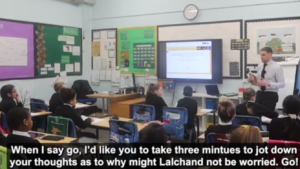05.01.24How Scott Wells Checks for Understanding as His Students Read (with Video)

Scott in action…
We recently shot an amazing round of video in Scott Wells’ classroom at Goldsmith Primary Academy in Walsall…. We generated clip after clip of masterful teaching several of which we’ve already begun sharing in workshops.
In fact I had the pleasure of showing a clip of Scott Checking for Understanding to participants at a session for ConnectED, which is a PD collaboration between The Two Counties Trust and Beckfoot Academies Trust, yesterday evening.
Thought I’d take it as an opportunity to share this outstanding clip with the rest of you.
Scott is reading The Firework Maker’s Daughter with his year 5s (4th grade in the US), and as they read aloud together (hooray!) he pauses to check for understanding.
You can see he’s planned this moment carefully because he’s chosen the exact sentence he thinks students might misunderstand and he’s prepared to project it to the class.
“When I say go, I want you to take three minutes to jot down your thoughts. Why might Lalchand not be worried?”
A couple of key details:
First I love the midstream CFU–in the course of reading–and I love that he is assessing students’ understanding directly from the text, ie before they have talked about it. A common pitfall of checking for understanding in reading classes is that the CFU comes after students have talked about the text and heard their fellow students’ insights. Once you’ve sat in on the discussion it’s pretty easy to describe the events in the book in a way that makes it appear that you read it successfully. Believe me I know… I did that more than a few times as a student (!). But whether they understand the book is a different question from whether they are able to generate meaning from it directly from the reading. This is an insight that is useful beyond reading classes, I think:
In science class you look at a data set. You talk about it. Then you ask to check for understanding: What does the data tell us? That’s a great move. I want students to be able to incorporate insights from the class into their own understanding. But I also want to make sure they can make sense of data directly and on their own without the support of peers as they will sometimes be asked to do. I could imagine something similar reading primary texts in history.
Scott’s language in releasing students to the writing task is aces, in my book. There are phrases that deliberately lower the stakes and signal that we are still in a formative place where understanding is developing. “Jot down” your thoughts (versus “write them” or “explain them”); Why might Lalchand not be worried (versus why “is” Lalchand worried). These make students feel like they don’t have to have everything figured out yet.
In the session with ConnectEd, participants reflected quite a bit on the tension between speed and thoroughness in Checking for Understanding. Scott wants data on the thinking of as much of the class as possible but he needs to move quickly and not bog down the whole lesson in the process of checking.
He does an A+ job of that. The fact that students write allows him to circulate and read over their shoulders… he’s taking notes as he goes… so within those few minutes he’s seen just about everyone’s work and he knows what the common misunderstandings are. But because he has such strong routines for common tasks installed… as soon as he says “go” everyone is writing… they are familiar with the task so their working memory is focused on the book… and there’s no time lost… and by looking and taking notes he is able to find and use a student, Ilya, to voice a model answer.
Then when they’ve discussed it a bit, Scott does something simple but important. He sends them back to revise the work. They don’t just hear the answer from a classmate and the teacher. They re-write their own answers to make sure they’ve got it down.
Great work from Scott—more video of his class to come so watch this space!–and thanks to everyone at yesterday’s session for their insights.
